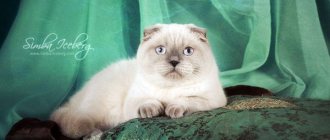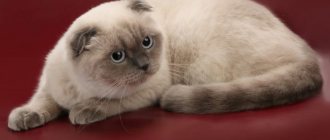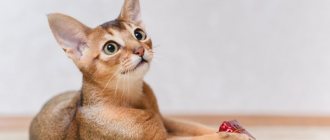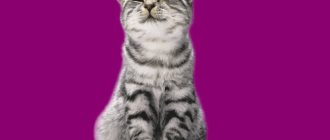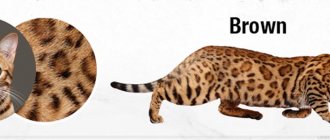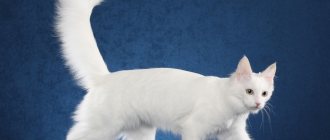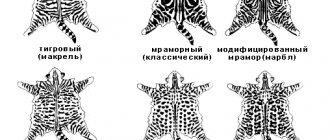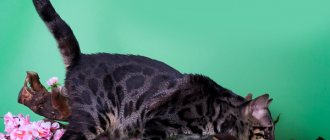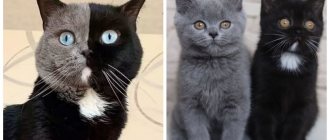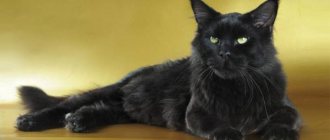1
The color of a purebred British cat determines its belonging to a particular breed and is an important breed characteristic. Coloring | Coat coloring is always genetically linked to the pigmentation of the paw pads and nose, as well as to the pattern on the coat. Thus, a blue cat should have fully pigmented paw pads. If at least one pink spot is found on them, according to the rules of felinology, which approves breed standards, it will be considered not blue, but blue-cream.
Color is an important breed characteristic, along with the size and shape of the body, the location of the ears and eyes on the head, and the shape of the tail. There are breeds in which color is not one of the breed characteristics. These include sphinxes, devoid of hair as such. In other representatives of the domestic cat, color accounts for over 30% of the breed standard. These rules apply when evaluating the following breeds:
- Abyssinian;
- Bengali;
- Korats and a number of other purebred cats.
The British have a large number of colors recognized as the breed standard. The classic color is the monochromatic blue, which appeared with the breed. From her came other, including rare types of colors of the British breed.
Today, over 200 colors of British cats have been registered in felinology, which have their own coding and are necessarily indicated in the pedigree.
Varieties of colors of British cats
The parameters of one or another color of the British include not only the color of the coat. The tone of the undercoat, the pattern on the coat, the color of the nose and paw pads, and even the color of the eyes are important. Only British kittens that strictly meet the color standards should receive pedigrees. But in practice, sometimes these rules are not observed so strictly, so when purchasing, you should only contact trusted nurseries.
Hurry up, choose a box and find out what gift awaits you
Discount on pet insurance
Promo code copied to clipboard
British cats have only two colors: black and red. The remaining colors are only derivatives of the main ones, as breeders say, by diluting (colored) and suppressing (white) the color.
In order for an animal to meet the breed standard, it is necessary that it be evenly colored, every hair from tip to root must be dyed, there should be no white hairs (excluding, of course, white color), heels and noses must be even in color, without spots, residual Tabby spots should not be visible. Eyes - orange, dark golden, copper (exceptions are allowed in white and color-point animals).
Solid colors of the British
Some of the solid (with an emphasis on the "o"), or solid colors - such as blue - are the ancestors of the British colors, and some - new colors - were obtained through the labor-intensive work of breeders. The rarest solid colors are cinnamon and fawn.
White
Snow-white without yellowness. Kittens may have black or gray spots on their heads from birth, which disappear with age. The eyes can be blue, and heterochromia (difference of eyes) also occurs. Breeding experiments with this color have ended because too many kittens are being born with health problems. For example, deafness in white cats with blue eyes is common.
Black
The coal-black, raven-wing colors of British cats give the animal a witchy, magical appearance. But, unfortunately, it is difficult to guess that a black kitten will become a blue-black cat. Very often, kittens change color around six months, changing the color of their fur to chocolate.
Chocolate
The richer and darker the better. Kittens that have faded from black are usually not the most successful (brown) color. Noble dark chocolate is desirable.
Blue
It can be a little lighter and a little darker. The bluer the shade, the more valuable it is. The undercoat is sometimes lighter than the main hairs, but the difference should be minimal.
Lilac
A complex color that is a cross between blue and pink. The result of selection work. Kittens are born dull pink; With age, the animal acquires a light coffee-with-milk shade, with a pinkish tint.
Cream
Beige or peach shades. Kittens can be born with a variegated coat, but then the variegation goes away.
Faun
"Deer" color, even lighter than cinnamon cinnamon. In infancy, such a kitten can be confused with a cream kitten, but the older the pet, the more clearly the gray tone appears (in cream cats, red predominates).
Cinnamon (cinnamon)
A rare color, cinnamon color, similar to light chocolate with the addition of an orange tint.
Character
The British cat is endowed with good manners from birth. She is sociable, but at the same time she will not impose herself and can calmly sit alone.
What is special about representatives of this breed:
- They, like true English aristocrats, rarely allow themselves to run and frolic around the apartment in vain. The cat prefers to move smoothly and impressively around the room, without creating unnecessary noise.
- Too active games are not for them, as the British quickly get tired and lose interest in new fun.
- They are characterized by intelligence. The cat will obediently wait to be petted, and only then will it try to free itself carefully and unnoticed.
- British cats are not annoying and will not make noise at night, demanding food or attention. The pet can calmly wait until the morning while you sleep.
- They are very neat. It seems that such cleanliness is in their blood. After all, even small kittens try to go to the litter box as soon as they learn to walk.
- The animal easily tolerates loneliness. They are not bored in an empty apartment, but they are always happy to greet the owner at the door.
- Despite the fact that these cats try to prove themselves as independent and independent members of the family, they still need affection, communication and attention. But only when they themselves want it.
- This is a very smart and wise animal that can easily adapt to the atmosphere in the house. The pupil also follows the rules dictated by the owner.
- The pet gets along easily with other animals and gets along with children. If conflicting circumstances arise, the cat simply leaves and sits in another room.
If you find an approach to your furry pet and raise it correctly, then it will not cause any problems.
Color point colors
Color introduced into the breed by breeders. Sometimes it is also called “Siamese” or “Himalayan”. It has a rich palette of shades. According to the standard, a light body without spots and darkened legs, head, and tail. Wool with white undercoat. The eyes are blue, from watery-transparent to sapphire, bright blue, which is especially appreciated.
British pointing kittens are born almost white, with dark fur growing into adolescence, or even later. Over the years, both light and darker coats darken.
Black point (classic, seal point)
The most common color. On the body, the fur coat can range from white to almost chocolate color; the point markings are dark brown, turning into black. The nose and paw pads are black or black-brown.
Chocolate point
Rare beautiful color, one of the brightest. The cat's body is creamy in color, and the point markings are a rich chocolate color, which should be even and bright. The nose and paw pads are brown, maybe with a pinkish tint.
Blue point
Delicate, soft color. Cold tone. Gray-blue body and blue point markings. Looks very harmonious with ice blue eyes. The nose and paw pads are gray.
Lilac point
In this color there should be no sharp boundaries between the main color (white or almost white with a pinkish tint) and the gray-pink point markings. However, the difference in tones should be clearly visible. The nose and paw pads are gray-pink.
Red point
Quite a rare color. White or with a reddish tint coat, bright red point spots. The brighter the red, the better. Ideally, brick red color. The nose and paw pads are red to coral.
Cream point
Delicate creamy body color and smooth, easy transition to creamy point markings. The brightest spots are pink or coral nose and paw pads, as well as blue eyes.
Color point tortoises
A combination of two colors: color point and tortoiseshell. Delicate interesting color. Light body and spotted, mosaic markings. Point marks may contain a combination of any colors from the palette; soft, pastel colors are valued. The nose and paw pads match the base color.
Smoky color point
An interesting miracle of nature, or rather, the result of the work of breeders. Cats are carriers of two colors. The body can be any of the "smoke" colors: black smoke, blue smoke, lilac smoke, chocolate smoke, red smoke, cinnamon and fawn. Point markings are the same color, but darker. The undercoat is white, the nose and paw pads match the color.
Veiled color point
There are two types: on silver and on gold. On a silver-white or peach undercoat. Tipping on the back colors 1/8 of the hair in the tone of one color or another, point spots of the same color: black, blue, lilac, chocolate, red, cream, cinnamon and fawn. The nose and paw pads match the color.
Shaded color point
There are two types: on silver and on gold. On a silver-white or peach undercoat. Tipping on the back colors 1/3 of the hair to match the color of a particular color; point marks without sharp boundaries can be small. Black, blue, lilac, chocolate, red, cream, cinnamon and fawn. The nose and paw pads match the color.
Color point bicolor
Consists of two colors: white and any of the palette with point marks. As a rule, the chest, part of the body, the front legs are white, and there are also white spots on the cheeks. The symmetry of white spots and their harmonious arrangement are appreciated. Markings include black, blue, lilac, chocolate, red, cream, cinnamon and fawn. The nose and paw pads match the base color.
Fawn point
Light sandy body and light brown and beige markings. Exactly the deer shade, without the redness. Beige nose, beige paw pads.
Cinnamon Point
A very rare color, a breeders dream. Ivory coat and red-brown pointing markings. Red and pink-brown nose and paw pads.
Health and illness
British cats are considered strong and healthy pets compared to other breeds. If you provide them with proper care, the pupil can live up to 20 years, and still be active and cheerful.
The fact is that almost all artificially bred breeds undergo many changes in the body. This cannot be said about the British, because this breed practically does not change during crossing.
What you should pay attention to:
- Since the breed is prone to obesity, avoid overeating. This can have a bad effect on your pet’s digestion, as well as its cardiovascular system.
- You should not feed your animal exclusively hard and dry food, otherwise constipation may occur.
- It is important to regularly examine your pet's mouth to rule out dental problems.
- It is known that the entire cat family loves to lick itself, eating its own fur. Lumps may cause stomach upset. To avoid such a nuisance, special pastes are purchased that remove hair. They have a pleasant taste and cats eat them with pleasure.
- A real problem for the British is a fungal disease that appears on the claws. Therefore, you need to systematically examine their paws.
Vaccinations
Preventive vaccinations need to be done annually, but only if the cat is absolutely healthy. Timely vaccination will help protect your pet from many infectious diseases, for example:
- calcivirosis – damage to the respiratory tract and oral cavity;
- rhinotracheitis is a disease that affects the respiratory system and eyes;
- rabies.
You also need to get rid of worms every 3 months. This procedure is carried out 10 days before vaccination.
Tortoiseshell colors
The amazing thing about calico cats is that each one is unique. There are no identically colored turtles. Color types: finely spotted or patchwork, calico (spots on white). A very interesting joke of nature: only cats are tortoiseshells. Well, practically. Calico cats are much more rare than white crows. Cats can have such colors only due to a genetic error with chromosomes. Most breeders and felinologists, having worked with animals all their lives, have never encountered tricolor cats. But yes, one day such a kitten may be born. Unfortunately, there will be no offspring from him, although history knows exceptions. Turtles also include chimera cats, which amaze everyone with their appearance, whose faces are neatly painted in different colors. Chimerism is also a genetic anomaly.
There are six main subgroups of this color: classic tortoises, smoky tortoises, torbie (tortoiseshell tabby), tortie (tortoiseshell point), calico (patchwork tortoise) and mixed color (tortoiseshell tabby and white).
Bicolor tortoiseshell
This color is also called calico, or patchwork tortoiseshell. The brightest, most elegant color. On a white background there are colored spots, the boundaries of which are not blurred or mixed. The spots can be any color from the palette. Pigmented spots should cover more than a third of the body surface. If there are few colored spots on a white background, such animals are called harlequin or van.
Black and red tortoiseshell
Ideally, a cat should have approximately 50% red and 50% black spots. The brighter the spots, the better. Brownish and beige spots are the same red color, only lightened. According to the standard, a red spot on the forehead is very desirable.
Chocolate red tortoiseshell
Interesting, rarely seen color. Ideally, a cat should have approximately 50% red and 50% black spots. The brighter the spots, the better. There should be a light spot on the forehead.
Blue-cream tortoiseshell
Soft, delicate, very noble color. Pastel colors (blue and cream) blend smoothly into each other. White spots and even hairs are not allowed.
Lilac-cream tortoiseshell
Purple and cream spots are neatly distributed throughout the animal's body. White inclusions are not allowed. There should be a cream spot on the cat's face.
Cinnamon-red tortoiseshell
Rare tortoiseshell color variant. The color of the fur coat is warm and rich. The spots are evenly distributed; there should be a red spot on the animal's face.
Fawn-cream tortoiseshell
This color is rare. The spots are not bright, but nevertheless they should have a different color. White wool and residual tabby color are not allowed. But there should be a cream mark on the forehead.
Tabby colors
The main signs of a tabby (or wild color) are the letter M located on the animal’s forehead (according to legend, this is the sign of a scarab), dark stripes near the eyes and on the cheeks, as well as rings (necklace) on the neck and chest.
Marbled Tabby
Dark circles, swirls and patterns on a light background. The pattern should be clear, not tangled or intersecting.
Spotted Tabby
Stripes on the cheeks, a dotted stripe along the ridge, and spots on the sides, preferably clearly defined and bright, are required. The cat is a micro-leopard.
Striped tabby
Brindle (sprat, mackerel, striped) is the most common tabby color. Mackerel (mackerel) fish, as well as sprat fish, have tiger stripes on their scales, just like cats have on their fur, hence the name.
Distinctive features are a dark stripe along the ridge, extending onto the tail, and striped sides. It is important that the stripes are not interrupted and do not turn into spots. The cat is a micro-tiger.
Patterned with white (torbico)
Quite a rare color, consists of three: tabby, tortoiseshell, white. On a white background there are colored spots with one of the tabby patterns.
Pictured tortoiseshell (torby)
The animal has a tabby pattern under any of the coat colors (black-red, chocolate-red, blue-cream, lilac-cream, as well as cinnamon-red and fawn-cream).
Silver tabbies
The cat's fur has a black pattern (stripes, spots, marble), and a white and silver undercoat.
Golden tabbies
The cat's fur has a red pattern (stripes, spots, marble), and an apricot undercoat.
Feeding
British cats are not whimsical and rarely go overboard with their food, but they still need a balanced diet and clean water.
Take the time to create a special diet for them, because the British have a good appetite and are prone to obesity.
If the food consists of natural products, then it is better to feed:
- beef (lean);
- chicken;
- fish (boiled);
- egg yolk;
- dairy products.
Vegetable puree from zucchini or carrots will also work.
From dry food, it is better to choose Super Premium food, as well as canned cat food, according to their age.
For example, many pet stores offer Royal Canin food exclusively for the British shorthair or longhair breed.
Silver chinchilla
It is still a rare, difficult to breed, but very beautiful, “royal” variety of the British cat. The color is so named because of its resemblance to the fur of real chinchillas.
The beauty is the owner of a snow-white fur coat with a “spraying” of the main color tone, black or blue. No yellow shades of wool are allowed. The nose and paw pads should match the base color. The eyes are necessarily green, except for the pointed subspecies. The colors differ in the degree of coloring of the hairs.
Silver shaded
Shaded is when only the upper third of the hairs are colored in the main color. In all other respects, the animal looks like it has a solid color, only slightly “dusted.” This effect is achieved due to the fact that each hair has a colored tip. The undercoat is white.
Silver veiled
Veiling is when the top 1/8 of the hairs are colored. In all other respects, the animal looks the same as with a solid color, only in a barely visible transparent “veil”. This effect is achieved due to the fact that each hair has a colored tip. The undercoat is white.
Price
The prices for these plush cats vary greatly:
- The cheapest British kittens can cost from $50, but it is not known whether it is worth buying for that price, and what they will eventually grow into.
- The average price for a purebred British kitten ranges from $150 to $250.
- The cost of an adult British cat, which can be used for further breeding of the breed, varies from 300 to 500 dollars.
- If you want to buy a show class cat and want to build a show career for it, then be prepared to pay up to $2,000 for it.
Golden chinchilla
An even rarer, difficult to breed, but very beautiful, “sunny” variety of the British cat. Its color is so named because of its similarity to the fur of real chinchillas.
This cat wears a bright apricot-colored coat with black or blue “spraying.” The brighter the gold, the more valuable it is. Gray shades are not allowed. The nose and paw pads should match the base color. The eyes are necessarily green, except for the pointed subspecies. The colors differ in the degree of coloring of the hairs.
Golden shaded
Shaded is when only the upper third of the hairs are colored in the main color. In all other respects, the animal looks like it has a solid color, only slightly “dusted.” This effect is achieved due to the fact that each hair has a colored tip. The undercoat is peach or apricot.
Golden veiled
Veiling is when the top 1/8 of the hairs are colored. In all other respects, the animal looks the same as with a solid color, only in a barely visible transparent “veil”. This effect is achieved due to the fact that each hair has a colored tip. The undercoat is peach or apricot.
Care and maintenance
The British woman feels great both in a small apartment and in a private house. Before you decide to buy an animal, look for a secluded place in the house where it will be comfortable and cozy. You can buy a special bed, or you can lay a soft blanket.
Do not forget that your pet has predatory instincts, so it is advisable to walk it.
Caring for a British cat, be it a short- or long-haired representative, is not difficult. Here you don’t have to spend a lot of time and money to make your pet attractive.
Hygiene
Grooming is considered the main hygiene procedure. For short-haired Britons, it is enough to comb them once a week, for long-haired ones – 2-3 times. But the most important period is molting. Then both of them need daily combing. To do this, you need to purchase a special rubber brush, which more easily removes dead hairs from the thick undercoat.
It is very important to keep your cat's litter box clean and to wash feeding bowls periodically. Ear and eye cleaning is mandatory. Trim nails as needed. If you wish, you can buy a scratching post.
Kitten care
Kittens need more frequent inspection of their ears and wiping their eyes with a cotton pad dipped in boiled water.
Bathing
The British cat does not tolerate water procedures easily and without much pleasure, but washing should be organized at least once a year. When washing, it is important not to wet your head and ears. For bathing, use only special shampoo for soft coats. You cannot dry it with a hairdryer. At the end of the procedures, wet the animal well with a towel.
Smoky colors
“Smoky” can be any of the colors, the main thing is that the undercoat should be lighter than the main color, preferably white. This is one of the varieties of hair color distribution. About half of the hair is colored, and closer to the root half is white. There are also “cameo” colors, in which the color of the undercoat almost merges with the color of the main hairs.
Classic smoky
“Smoke” is superimposed on the same solid coat colors: black-red, chocolate-red, blue-cream, lilac-cream, as well as cinnamon-red and fawn-cream. The undercoat is silvery-white.
Smoky bicolor
The cat has a symmetrically and harmoniously distributed white color and “smoky” spots of any color. The undercoat is white, the nose and paw pads match the base color.
Colors with white
A cat can have any of the following colors: black, blue, lilac, chocolate, red, cream, cinnamon and fawn, as well as a combination of these plus white spots. One fourth (no less!) part of the body should be white - this is the chest, front legs, cheeks, and belly. The nose and paw pads should match the base color.
Classic color with white
Strictly speaking, this is a two-colored cat. Elegant white spots (yellowishness is not allowed) and a fur coat of any of the classic colors. The nose and paw pads match the base color.
Smoky color with white
The cat has a symmetrically and harmoniously distributed white color (chest, paws, cheeks) and “smoky” spots of any color.
Color point with white
The elegant coat of such a cat is painted in two colors: white and any of the palettes with point marks. The chest and front legs are white, and there are also white spots on the cheeks. The symmetry of white spots and their harmonious arrangement are appreciated. Markings of black, blue, lilac, chocolate, red, cream, cinnamon and fawn. The nose and paw pads match the base color.
Colors with white tabby
The same patchwork turtles, only some spots may have a tabby pattern. Rarely seen, it is considered a combination of three colors. There may also be spots of the same (any) color, on which a tabby pattern appears (stripes, spots, marble).
How to determine the color of a British cat?
If you really need a kitten of a certain color, you should contact a cattery with a good reputation. It’s not a fact that you will immediately find what you want, especially if the color is rare. Ask for photos, videos; Perhaps they will show you the baby on Skype. Then it’s time to go and choose.
To begin with, visually, but the kitten must already be mature (3-4 months). In babies, the color may change color.
Look at the kitten's parents, talk with the owners, study the breed codes and the summary color table. The exact details of cat fathers and mothers must be indicated in their documents. Using the table, you can determine which kittens a given pair of producers may have.
Well, or you can contact a specialist, an expert felinologist. In the case of rare and complex colors, it is better not to take risks. Interestingly, all cats are initially wild-colored (tabby). That is, spotted. But due to a combination of genes, this color is hidden. Nature's jokes can be observed in small kittens, which, being born with spotted fur, change to one color within a couple of months.
Story
The first mentions of this breed are found in ancient chronicles. There is no documented information about their origin. The first very large rat-catching cats were brought in by Roman centurions. Researchers suggest that cats were introduced by the Romans during an attack on the British Isles in 43 AD. e. In Britain they were called the “British cat”, in France - “Charteuse”, in Germany - “Carthusian cat”.
The animals were used as rodent hunters, but by the end of the 16th century, breeders paid attention to the appearance of cats. The British attended the first London cat show in 1871. Then official breed standards were adopted, and felinology began its rapid development.
The first British appeared in Russia in 1992, along with the Cartheusers, who are now called in Russia “the old type of British.”
To consolidate the unique features of the British, breeders used Persian cats - which is why British cats have a slightly flat face.

